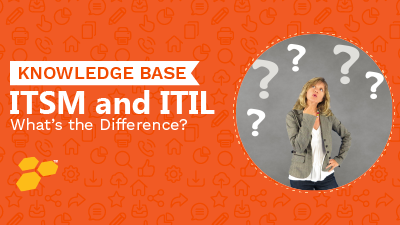
Introduction
By: Stuart Rance
If you’re not sure whether you need ITSM or ITIL®, then I’m pretty sure you’re asking the wrong question.
It’s not an “either/or” decision. IT service management (ITSM) is what you do to manage the services you deliver to your customers, even if you don’t actually use that term. ITIL is a best practice framework for ITSM, and you should think about adopting some ideas from ITIL to help you work more effectively.
Difference between ITSM & ITIL
Let’s start with a quick overview of what these terms stand for:
ITSM
ITSM is an acronym for IT service management. It simply means how you manage the information systems that deliver value to your customers. Even if you’ve never heard the term ITSM, if you’re running IT systems, then you are doing ITSM. ITSM could include activities like planning and managing changes so they don’t cause disruption to the business, fixing things when they go wrong, or managing a budget to ensure you can pay the bills when they arrive. People who use the term ITSM tend to think of IT as a means of delivering valuable services to their customers, rather than as a way to manage technology—but even if you have a completely technical focus, your work still needs to be managed, and that’s what we call ITSM.
ITIL
ITIL is the name of the world’s most widely recognized framework for ITSM. ITIL is a registered trademark of AXELOS, which owns a range of best practice solutions and their corresponding publications and exams. ITIL has been adopted by many organizations, and there are millions of certified ITIL practitioners worldwide.
Benefits for ITIL
It is likely that some – probably many – of the ITIL best practices would prove beneficial to your organization. Organizations that adopt ITIL often find that they:
You don’t have to adopt ITIL to manage your IT services effectively and efficiently, but it can certainly help. Some organizations simply create their own set of processes for running IT, and this can work. But it’s hard to develop something original that matches the years of experience that have gone into the development of the ITIL best practice framework that has now been adopted by many thousands of organizations.
Adopt and Adapt to Fit Your Needs
IT organizations that make use of ITIL decide for themselves which aspects to adopt. Many IT organizations choose to adopt only the operational processes, such as incident management and change management. On their own, these do provide some value, of course, but they are only a small part of the whole ITIL framework. However, you’ll get the best value from ITIL by taking a lifecycle approach to ITSM. This covers everything from your overall IT strategy through the design, transition, and operation of services; and it incorporates continual improvement into everything you do.
When your organization has made the decision to adopt a best practice framework, a smart strategy is to understand which approach will be a good fit for your organizational culture and to incorporate it into your own management system in a sympathetic way. I have worked with many organizations that start our relationship by telling me they tried ITIL a few years ago, but it didn’t deliver any value. When I investigate what happened, I usually discover they attempted to adopt a rigid set of processes, with no understanding of how they would fit within the culture of their organization. As a result, people would ignore the new processes—so the money spent on the project ended up being wasted. The right way to use ITIL is summarized in the phrase “adopt and adapt.” You only adopt the parts that you need, and you adapt the ideas to fit your environment rather than slavishly following the guidance.
Additional Frameworks to Explore
The smartest organizations tend to use other standards or best practice frameworks in combination with ITIL. This can be very effective as each approach brings something different to the mix. For example:
If you run IT services, you owe it to your customers to adopt ideas that will make you effective, efficient, and agile. So maybe it’s time you had another look at ITIL to see what it has to offer.

